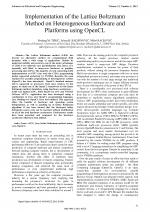| 1/2012 - 9 |
Implementation of the Lattice Boltzmann Method on Heterogeneous Hardware and Platforms using OpenCLTEKIC, P. M. |
| Extra paper information in |
| Click to see author's profile in |
| Download PDF |
Author keywords
GPU, Java, lattice Boltzmann method, many-core, OpenC
References keywords
lattice(17), boltzmann(15), performance(5), fluid(5), flow(5), simulation(4), parallel(4)
Blue keywords are present in both the references section and the paper title.
About this article
Date of Publication: 2012-02-28
Volume 12, Issue 1, Year 2012, On page(s): 51 - 56
ISSN: 1582-7445, e-ISSN: 1844-7600
Digital Object Identifier: 10.4316/AECE.2012.01009
Web of Science Accession Number: 000301075000009
SCOPUS ID: 84860735612
Abstract
The Lattice Boltzmann method (LBM) has become an alternative method for computational fluid dynamics with a wide range of applications. Besides its numerical stability and accuracy, one of the major advantages of LBM is its relatively easy parallelization and, hence, it is especially well fitted to many-core hardware as graphics processing units (GPU). The majority of work concerning LBM implementation on GPU's has used the CUDA programming model, supported exclusively by NVIDIA. Recently, the open standard for parallel programming of heterogeneous systems (OpenCL) has been introduced. OpenCL standard matures and is supported on processors from most vendors. In this paper, we make use of the OpenCL framework for the lattice Boltzmann method simulation, using hardware accelerators - AMD ATI Radeon GPU, AMD Dual-Core CPU and NVIDIA GeForce GPU's. Application has been developed using a combination of Java and OpenCL programming languages. Java bindings for OpenCL have been utilized. This approach offers the benefits of hardware and operating system independence, as well as speeding up of lattice Boltzmann algorithm. It has been showed that the developed lattice Boltzmann source code can be executed without modification on all of the used hardware accelerators. Performance results have been presented and compared for the hardware accelerators that have been utilized. |
| References | | | Cited By |
Web of Science® Times Cited: 5 [View]
View record in Web of Science® [View]
View Related Records® [View]
Updated 2 weeks, 6 days ago
SCOPUS® Times Cited: 6
View record in SCOPUS® [Free preview]
View citations in SCOPUS® [Free preview]
[1] Esoteric Pull and Esoteric Push: Two Simple In-Place Streaming Schemes for the Lattice Boltzmann Method on GPUs, Lehmann, Moritz, Computation, ISSN 2079-3197, Issue 6, Volume 10, 2022.
Digital Object Identifier: 10.3390/computation10060092 [CrossRef]
[2] Accuracy and performance of the lattice Boltzmann method with 64-bit, 32-bit, and customized 16-bit number formats, Lehmann, Moritz, Krause, Mathias J., Amati, Giorgio, Sega, Marcello, Harting, Jens, Gekle, Stephan, Physical Review E, ISSN 2470-0045, Issue 1, Volume 106, 2022.
Digital Object Identifier: 10.1103/PhysRevE.106.015308 [CrossRef]
[3] Graphics Processing Units and Open Computing Language for parallel computing, Perelygin, Kyrylo, Lam, Shui, Wu, Xiaolong, Computers & Electrical Engineering, ISSN 0045-7906, Issue 1, Volume 40, 2014.
Digital Object Identifier: 10.1016/j.compeleceng.2013.11.015 [CrossRef]
[4] Lattice Boltzmann Method Implementation on Multiple Devices using OpenCL, TEKIC, J. B., TEKIC, P. M., RACKOVIC, M., Advances in Electrical and Computer Engineering, ISSN 1582-7445, Issue 3, Volume 18, 2018.
Digital Object Identifier: 10.4316/AECE.2018.03001 [CrossRef] [Full text]
[5] Performance Comparison of Different OpenCL Implementations of LBM Simulation on Commodity Computer Hardware, TEKIC, J., TEKIC, P., RACKOVIC, M., Advances in Electrical and Computer Engineering, ISSN 1582-7445, Issue 1, Volume 22, 2022.
Digital Object Identifier: 10.4316/AECE.2022.01008 [CrossRef] [Full text]
Disclaimer: All information displayed above was retrieved by using remote connections to respective databases. For the best user experience, we update all data by using background processes, and use caches in order to reduce the load on the servers we retrieve the information from. As we have no control on the availability of the database servers and sometimes the Internet connectivity may be affected, we do not guarantee the information is correct or complete. For the most accurate data, please always consult the database sites directly. Some external links require authentication or an institutional subscription.
Web of Science® is a registered trademark of Clarivate Analytics, Scopus® is a registered trademark of Elsevier B.V., other product names, company names, brand names, trademarks and logos are the property of their respective owners.
Faculty of Electrical Engineering and Computer Science
Stefan cel Mare University of Suceava, Romania
All rights reserved: Advances in Electrical and Computer Engineering is a registered trademark of the Stefan cel Mare University of Suceava. No part of this publication may be reproduced, stored in a retrieval system, photocopied, recorded or archived, without the written permission from the Editor. When authors submit their papers for publication, they agree that the copyright for their article be transferred to the Faculty of Electrical Engineering and Computer Science, Stefan cel Mare University of Suceava, Romania, if and only if the articles are accepted for publication. The copyright covers the exclusive rights to reproduce and distribute the article, including reprints and translations.
Permission for other use: The copyright owner's consent does not extend to copying for general distribution, for promotion, for creating new works, or for resale. Specific written permission must be obtained from the Editor for such copying. Direct linking to files hosted on this website is strictly prohibited.
Disclaimer: Whilst every effort is made by the publishers and editorial board to see that no inaccurate or misleading data, opinions or statements appear in this journal, they wish to make it clear that all information and opinions formulated in the articles, as well as linguistic accuracy, are the sole responsibility of the author.



